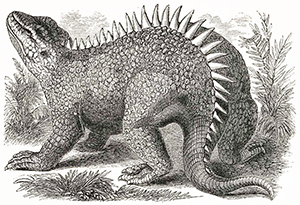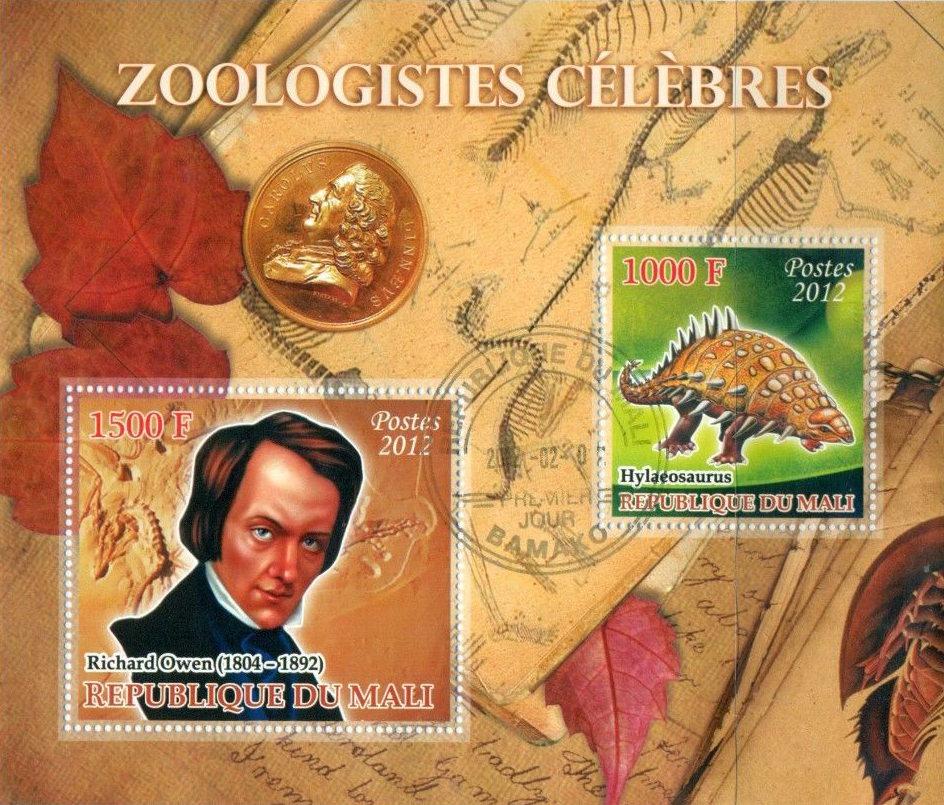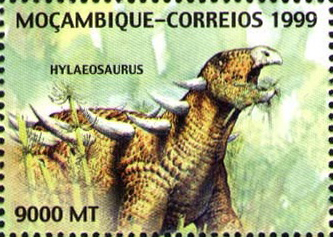Hylaeosaurus armatus Mantell, 1833

Benjamin Waterhouse Hawkins
nel 1871
(Da: it.wikipedia.org)
Phylum: Chordata Haeckel, 1874
Subphylum: Vertebrata Cuvier, 1812
Classe: Dinosauria Owen, 1841
Ordine: Ornithischia Seeley, 1888
Famiglia: Nodosauridae Marsh, 1890
Genere: Hylaeosaurus Mantell, 1833
Descrizione
Il nome deriva dal greco hyle (foresta) e sauros (lucertola), cioè il rettile delle foreste, con riferimento al luogo del ritrovamento, la foresta di Tilgate. Spesso confuso con il Polacanthus, l’Hylaeosaurus, descritto da Gideon Mantell nel 1833, era un animale pesante, lungo circa 5 metri, munito di una corazza ossea sul dorso e sulla coda e di lunghe spine ai fianchi. L'importanza di questo animale sta nel fatto che esso è stato il terzo genere valido di dinosauro descritto scientificamente, dopo il Megalosaurus e l’Iguanodon. L'unico resto fossile noto di Hylaeosaurus<7i>, oltre a un ritrovamento molto frammentario, è uno scheletro completamente inglobato in una roccia durissima e calcarea, che fino a poco tempo fa non ha permesso di esaminare bene le caratteristiche del fossile. Ora però si è riusciti a capire che questo dinosauro corazzato è piuttosto diverso da animali simili vissuti nella stessa epoca e negli stessi luoghi, come il Polacanthus e l’Acanthopholis.
Diffusione
Caratteristico del Cretacico inferiore (Valanginiano) dell'Inghilterra.
Sinonimi
= Hylosaurus Fitzinger, 1843.
Bibliografia
–Arbour, Victoria M; Zanno, Lindsay E; Gates, Terry (2016). "Ankylosaurian dinosaur palaeoenvironmental associations were influenced by extirpation, sea-level fluctuation, and geodispersal". Palaeogeography, Palaeoclimatology, Palaeoecology. 449: 289-299.
–Dennis R. Dean, 1999, Gideon Mantell and the Discovery of Dinosaurs, Cambridge University Press, 315 pp.
–Mantell, Gideon Algernon (1833). "Observations on the remains of the Iguanodon, and other fossil reptiles, of the strata of Tilgate Forest in Sussex". Proceedings of the Geological Society of London. 1: 410-411.
–Mantell, G.A., 1838, The Wonders of Geology or a Familiar Exposition of Geological Phenomena, 2 vols, Relfe and Fletcher, London.
–G.A. Mantell. 1833. The Geology of the South-East of England. Longman Ltd., London.
–Naish, D.; Martill, D.M. (2008). "Dinosaurs of Great Britain and the role of the Geological Society of London in their discovery: Ornithischia". Journal of the Geological Society, London. 165 (3): 613-623.
–Pereda-Suberbiola, J (1993). "Hylaeosaurus, Polacanthus, and the systematics and stratigraphy of Wealden armoured dinosaurs". Geological Magazine. 130 (6): 767–781.
–Barrett, P.M. (1996). "The first known femur of Hylaeosaurus armatus and reidentification of ornithopod material in The Natural History Museum, London". Bulletin of the Natural History Museum, Geology Series. 52: 115–118.
–Barrett, P.M. and Maidment, S.C.R., 2011, "Wealden armoured dinosaurs". In: Batten, D.J. (ed.). English Wealden fossils. Palaeontological Association, London, Field Guides to Fossils 14, 769 pp.
–Corroy, G (1922). "Les reptiles néocomiens et albiens du Bassin de Paris". Comptes Rendus de l'Académie des Sciences de Paris. 172: 1192-1194.
–Koken, E (1887). "Die Dinosaurier, Crocodiliden und Sauropterygier des norddeutschen Wealden". Geologische und Palaeontologische Abhandlungen. 3: 311-420.
–Sanz, J.L. (1983). "A nodosaurid ankylosaur from the Lower Cretaceous of Salas de los Infantes (Province of Burgos, Spain)". Geobios. 16 (5): 615-621.
–E. Posmosanu, 2003, "The palaeoecology of the dinosaur fauna from a Lower Cretaceous bauxite deposit from Bihor (Romania)". In: A. Petculescu & E. Stiuca (eds.), Advances in Vertebrate Paleontology: Hen to Panta. Romanian Academy, "Emil Racovita" Institute of Speleology, Bucarest pp. 121-124.
–Naish, D. and Martill, D.M., 2001, "Armoured Dinosaurs: Thyreophorans". In: Martill, D.M., Naish, D., (editors). Dinosaurs of the Isle of Wight. Palaeontological Association Field Guides to Fossils 10. pp. 147-184
–Sachs, S.; Hornung, J. J. (2013). Evans, David C (ed.). "Ankylosaur Remains from the Early Cretaceous (Valanginian) of Northwestern Germany". PLoS ONE. 8 (4): e60571.
–Mantell, G.A. 1844. The Medals of Creation: or first lessons in geology and in the study of organic remains. London Volume 2, pp. 587-876.
–Romer, A.S. 1956. Osteology of the Reptiles. University of Chicago Press, Chicago.
–Coombs, W. 1971. The Ankylosauria. Ph.D. thesis, New York: Columbia University.
–Mantell, G.A. (1841). "Memoir on a portion of the lower jaw of the Iguanodon and on the remains of the Hylaeosaurus and other saurians, discovered in the strata of Tilgate Forest, in Sussex". Philosophical Transactions of the Royal Society of London. 131: 131-151.
–Nopcsa, F., 1928, "Palaeontological notes on Reptiles", Geologica Hungarica, Series Palaeontologica, tomus, 1, -Pasc. 1, p. 1-84.
–Coombs, W.P. (1978). "The families of the ornithischian dinosaur order Ankylosauria". Palaeontology. 21 (1): 143-170.
–Blows, W.T. (1987). "The armoured dinosaur Polacanthus foxi from the Lower Cretaceous of the Isle of Wight". Palaeontology. 30 (3): 557-580.
–Palmer, D., ed. (1999). The Marshall Illustrated Encyclopedia of Dinosaurs and Prehistoric Animals. London: Marshall Editions. p. 157. ISBN 978-1-84028-152-1.
–Paul, G.S., 2010, The Princeton Field Guide to Dinosaurs, Princeton University Press p. 228.
–Carpenter, K., 2001, "Skull of the polacanthid ankylosaur Hylaeosaurus armatus Mantell, 1833, from the Lower Cretaceous of England", pp 169-172 In: Carpenter, K. (ed.). The armored dinosaurs. Indiana University Press, Bloomington and Indianapolis, 525 pp.
–Thompson, Richard S.; Parish, Jolyon C.; Maidment, Susannah C. R.; Barrett, Paul M. (2012). "Phylogeny of the ankylosaurian dinosaurs (Ornithischia: Thyreophora)". Journal of Systematic Palaeontology. 10 (2): 301-312.

|
Data: 02/02/2012
Emissione: Celebri zoologi Stato: Mali |
|---|

|
Data: 24/09/1999
Emissione: Natura Stato: Mozambique |
|---|